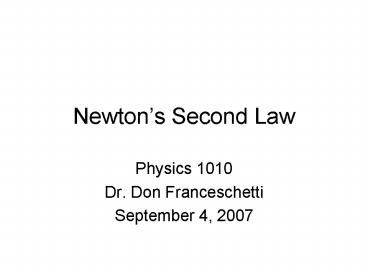Newtons Second Law - PowerPoint PPT Presentation
1 / 21
Title:
Newtons Second Law
Description:
Study problems from Linear Motion ... Between solid surfaces. Due to surface irregularities. Two kinds: static and dynamic (rolling is a third) ... – PowerPoint PPT presentation
Number of Views:330
Avg rating:3.0/5.0
Title: Newtons Second Law
1
Newtons Second Law
- Physics 1010
- Dr. Don Franceschetti
- September 4, 2007
2
Study problems from Linear Motion
- Calculate the speed and distance covered at 1, 2,
3, 4, and 5, seconds by. - A lead brick dropped from rest.
- A rock tossed upward at 20 m/s.
- c) A rock thrown downward at 20 m/s.
3
Guide Questions
- How does force relate to acceleration?
- Can an object have a velocity, a force, an
acceleration. - What is mass?
- What is meant by weightlessness?
- Is antigravity possible?
- How do objects respond when more than one force
acts on them?
4
Newtons First Law
- Every object continues in a state of rest, or of
uniform motion in a straight line, unless it is
compelled to change that motion by forces
impressed on it (i. e. a non-zero net force.)
5
Newtons First
- Q Consider a book that weighs15 N at rest on a
flat table. How many newtons of support force
does the table provide? What is the net force on
the book in this case? - Q If you push on a crate with a force of 100 N
and it slides with a constant velocity, how much
is the friction acting on the crate?
6
Linear Motion
- Q What kind of speed is registered by an
automobile speedometer, average speed or
instantaneous speed? - Q If a car moves with a constant velocity, does
it also move with constant speed?
7
Newtons Second Law
- On any body
- Net force mass x acceleration
- Mass measured in kilograms (Kg)
- 1 newton 1 kg m / s2
8
Algebra
- Fma
- aF/m, explains why bodies fall with same
acceleration in a vacuum - mF/a explains how astronauts can measure masses
9
A metric moment
- The kilogram is defined as the mass of a standard
platinum-iridium cylinder kept at the
International Bureau of Weights and Measures in
Paris, France - Someday the kilogram will be defined as the mass
of a specific number of atoms of a specific
isotope.
10
Weight
- The weight of an object is the strength of the
force the Earth (or other planet) exerts on the
object. - In free fall, gravity is the only force at work,
and it produces an acceleration of g9.8m/s2 - Thus the weight of a kilogram is its mass times
that acceleration - 9.8 kg m/s2 or 9.8 newtons(N)
11
That abominable English system
- Distances are measured in feet
- Time is measures in seconds
- g32 ft/s2
- The pound is the unit of force
- The slug is the unit of mass (really!)
- 1 pound 1 slug ft/sec2
- One slug has a weight of 32 pounds
12
Apparent Weight
- Your apparent weight is the force that a scale
must supply to make the net force on you equal to
your mass x acceleration - Think about elevators
- Free fall apparent weight is zero, gravitational
force is generally not zero
13
Mass and weight
- Mass can be thought of as the quantity of
matter or resistance to acceleration. It does
not change. - Weight depends on where you are.
- Can measure mass by relative weighing.
- Question, how would baseball be different on the
moon?
14
Difference between mass and weight
15
Space Age Misconceptions
- There is no gravity in a vacuum.
- NASA has built a zero gravity chamber.
- Gravity is the same as air pressure.
- Gravity pushes down.
- Gravity is the same as magnetism (William Gilbert
1600 A. D.)
16
Artificial Gravity
- Centrifugal force actually your tendency to
move in a straight line while a restraint makes
you accelerate. - Measured in gs
- Amusement Parks
- Aerobatics
- Centrifuges
17
Normal Force
- Perpendicular to solid surface
- As big as it needs to be!!! (unless surface
breaks) - Caused by microscopic deformations
18
Friction
- Between solid surfaces
- Due to surface irregularities
- Two kinds static and dynamic (rolling is a
third) - Static friction depends on the other forces at
work. There is a maximum proportional to normal
force - Kinetic friction is a set fraction of the normal
force in size - Friction is independent of contact area and speed
19
Air Resistance
- In very complicated
- Proportional to speed at low speeds, so we can
ignore it in many cases - Proportional to square of speed at highway speeds
- Discuss
- Gas economy
- Parachutes
20
Falling acceleration less than g
- a(down)(mg-Fair)/m
- At terminal velocity a0!
- Free fall ag
21
Do not confuse
- Mass
- Weight
- Velocity
- Acceleration
- force































